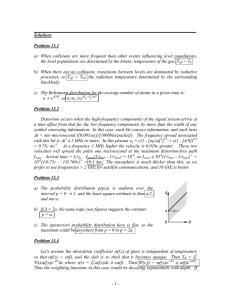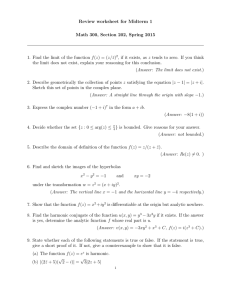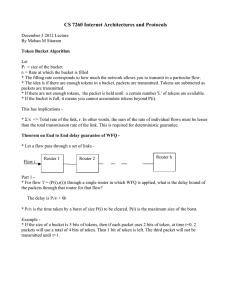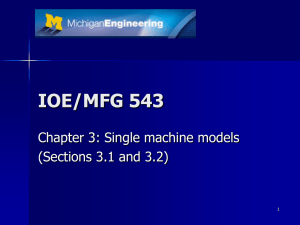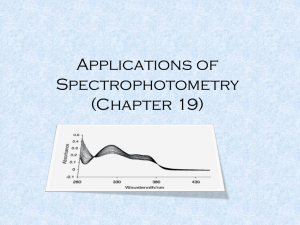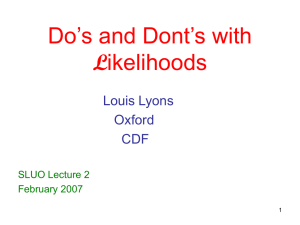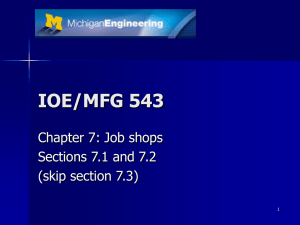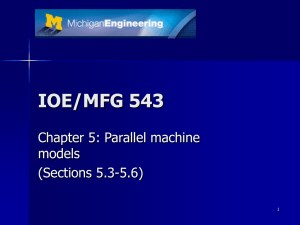ch 12-part1 (connected word).ppt
advertisement
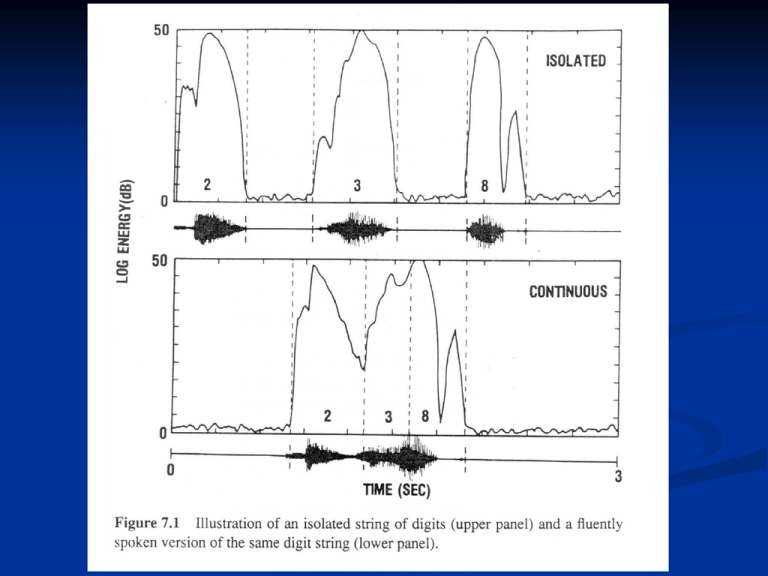
The connected word recognition problem
Problem definition:
Given a fluently spoken sequence of words, how
can we determine the optimum match in terms
of a concatenation of word reference patterns?
To solve the connected word recognition problem, we
must resolve the following problems
connected word recognition
Test pattern sequence of vectors :
T {t (1), t (2), , t ( M )} {t (m)}mM1
The set of word reference patterns (templates or models) :
Ri {ri (1), ri (2), , ri ( N i )} 1 i V
N i is the duration of the i - th reference pattern
The problem is to find R* , the optimum sequence of word
reference patterns :
R * {Rq*(1) Rq*(2 ) Rq*(3) Rq*( L ) }
connected word recognition
consider constructi ng an arbitrary " super reference" pattern
R s of the form :
R Rq (1) Rq ( 2) Rq (3) Rq ( L ) {r (n)}
s
s
Ns
n 1
in which N s is the total duration of the concatenat ed refernce
pattern R s
connected word recognition
The time aligned distance between R s and T is :
D( R s , T ) min
M
w( m )
s
d
(
t
(
m
),
r
( w(m)))
m 1
where d(.,.) is a local spectral distance measure and
w(.) is a warping function.
Optimize D :
D * mins D( R s , T )
R
M
min
min
Lmin L L max q (1), q ( 2 ),, q ( L )
1 q ( i ) V
and
min
w( m )
R * arg mins D( R s , T )
R
s
d
(
t
(
m
),
r
( w(m)))
m 1
connected word recognition
The required computatio n is :
M .L N q ( )
M .L.N L
L
1
V
CL
V (grid points)
3
3
e.g., M 300, L 7, N 40, and V 10,
then, C L 2.8 10 (grid points)
11
connected word recognition
The alternative algorithms:
Two-level dynamic programming approach
Level building approach
One-stage approach and subsequent
generalizations
Two-level dynamic programming algorithm
Two-level dynamic programming algorithm
D(v, b, e) min
w( m )
e
d (t (m), r (w(m)))
m b
v
~
D(b, e) min [ D(v, b, e)] best score
1 v V
~
N (b, e) arg min [ D(v, b, e)] best reference index
1 v V
Two-level dynamic programming algorithm
~
D (e) min [ D(b, e) D 1 (b 1)]
1b e
Step 1, Initializa tion
D 0 (0) 0,
D (0) ,
1 Lmax
Step 2, Loop on e for 1
~
D 1 (e) D(1, e), 2 e M
Step 3, Resursion, Loop on e for 2,3, , Lmax
~
D 2 (e) min [ D(b, e) D1 (b 1)], 3 e M
1b e
~
D 3 (e) min [ D(b, e) D2 (b 1)], 4 e M
1b e
~
D (e) min [ D(b, e) D 1 (b 1)], 1 e M
1b e
Step 4, Final Solution
D * min [ D ( M )]
1 Lmax
Two-level dynamic programming algorithm
Computation cost of the two-level DP algorithm is:
C 2 L V . M . N (2 R 1) (grid points)
The required storage of the range reduced algorithm is:
S 2L 2M (2 R 1)
e.g., for M=300, N=40, V=10, R=5
C=1,320,000 grid points
And S=6600 locations for D(b,e)
1
1
D (m), m11 (1) m m12 (1)
2
1
D (m), m21 (1) m m22 (1)
D (m), mV 1 (1) m mV 2 (1).
V
1
m1 (1) min [mv1 (1)]
1 v V
m2 (1) min [mv 2 (1)]
1 v V
D (m) min [ D (m)]
B
v
1 v V
N (m) arg min [ D (m)]
B
1 v V
F (m) F
B
N B ( m )
v
( m)
m1 (2) min [mv1 (2)]
1 v V
m2 (2) min [mv 2 (2)]
1 v V
D min [ D (m)].
*
1 Lmax
B
R RB RA RA RB
*
L(m) (m 1) / 2
U (m) 2(m 1) 1
m 1
L(m) max
,2(m M ) ()
2
1
U (m) min 2(m 1), (m M ( Lmax )
2
CLB V . Lmax . N . M / 3
S LB 3M . Lmax
grid po int s
D (m)
1 min
.
m1 ( 1)mm2 ( 1)
m
B
1
D ( m)
1
S arg
max
M T . 1 m S
m1 ( 1) m m2 ( 1)
m
B
D 1 (m)
2
2
S arg
max
M T . 1 m S .
m1 ( 1) m m2 ( 1)
m
B
1
1
c(m) arg
D* min
min
c ( m 1) n c ( m 1)
min
1 Lmax M END m M
[ D (m 1, n)]
v
[ DB (m)].
